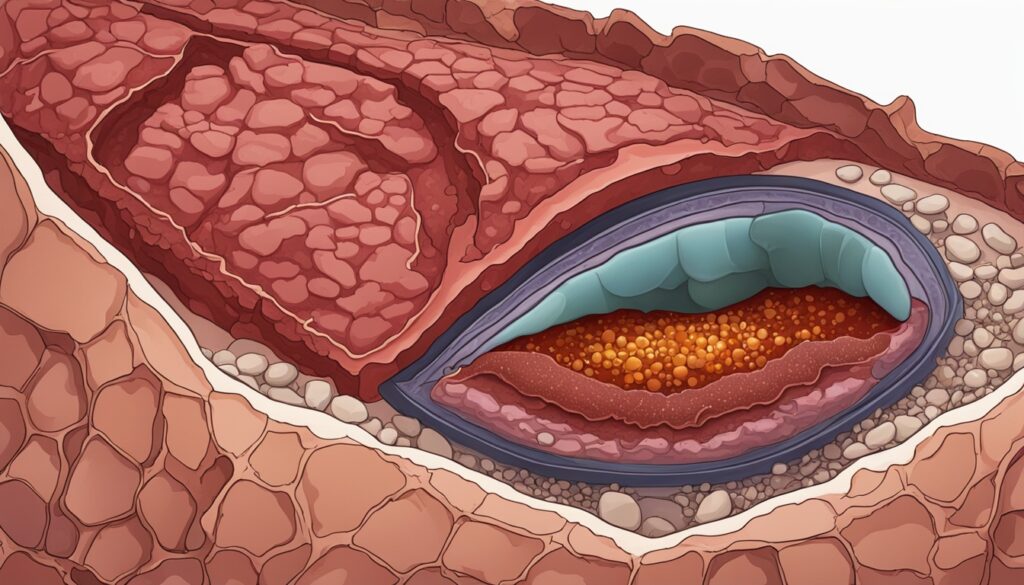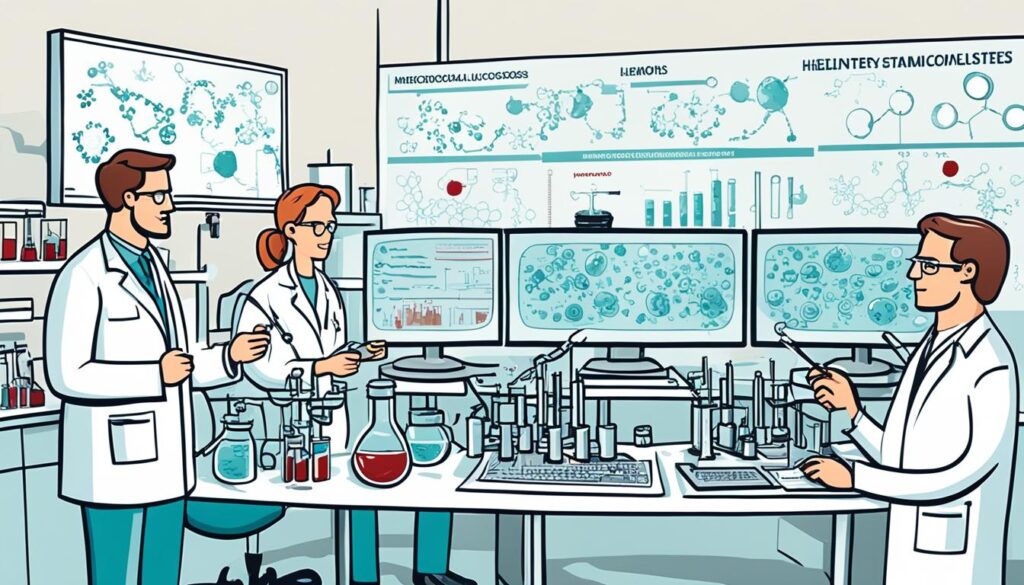Hemochromatosis is a genetic disorder that causes too much iron in the body. This iron gathers in organs like the liver, which can lead to a fatty liver. The link between hemochromatosis and fatty liver is complicated but is being studied. We aim to understand how they relate, their commonness, and what this means for treatment and diagnosis.
Table of Contents
TogglePeople with hemochromatosis have a higher chance of getting fatty liver disease. This is because too much iron in the liver messes up its normal job. This can cause a type of liver problem called nonalcoholic fatty liver disease (NAFLD). Knowing about the link is key to finding and treating both problems early.
What is Hemochromatosis?
Hemochromatosis is a genetic disorder that causes too much iron to build up in the body. It’s also called iron overload disorder. This can harm the liver, heart, and pancreas. Hemochromatosis has different types, each with its own causes and risks.
Definition and Overview
Primary hemochromatosis comes from changes in a gene called HFE. This gene helps control the iron the body takes in. There are known genetic changes, like C282Y and H63D, linked to primary hemochromatosis. Secondary hemochromatosis is caused by other health issues that raise iron levels.
Types of Hemochromatosis
The main cause of hemochromatosis is genetic. It links back to changes in the HFE gene. If someone gets specific mutations from both parents, they are more likely to get hemochromatosis. Other risks include family history, some backgrounds, and too much iron in the diet.
Causes and Risk Factors
Causes of hemochromatosis by genetic factors. Key genetic changes in the HFE gene play a big role. If a person gets specific mutations from both parents, their risk increases. Other things like family history, certain backgrounds, and too much iron in the diet raise the risk too.
Hemochromatosis and Liver Disease
Hemochromatosis is when too much iron builds up in the liver. This can cause many liver issues like inflammation and cirrhosis. The extra iron damages liver cells and causes other problems.
Iron buildup in the liver can cause many issues. It damages liver cells and leads to diseases like inflammation and cirrhosis. This can also cause problems such as fatty liver disease and liver cancer.
Iron Overload and Liver Damage
Too much iron in the liver harms it in many ways. This includes causing inflammation, fibrosis, and cirrhosis. It disrupts how the liver works, leading to other issues like fatty liver disease and cancer.
Prevalence of Liver Complications
People with hemochromatosis often face liver problems. Up to half of them might get liver damage without treatment. Many might get cirrhosis or liver cancer if not treated on time.
The seriousness of liver issues varies. It depends on the amount of iron in the liver and other health conditions. Early diagnosis and treatment are crucial.

Can Hemochromatosis Cause a Fatty Liver?
The Role of Iron in Fatty Liver Disease
Hemochromatosis and fatty liver disease are linked but not fully understood. Research looks into whether hemochromatosis can directly cause a fatty liver. Iron build-up in the liver is tied to nonalcoholic fatty liver disease (NAFLD) growth. Iron overload might lead to a fatty liver by causing more oxidative stress, messing up the way the liver handles fat, and resisting insulin.
Studies on Hemochromatosis and Fatty Liver
Many studies explore how hemochromatosis and fatty liver disease are related. Some suggest that people with hemochromatosis might get NAFLD more often. But, not all findings show a clear connection. The role of HFE gene mutations in fatty liver development isn’t always obvious. Researchers are still working to understand how iron overload, genes, and fatty liver risks in those with hemochromatosis.
Genetic Factors and Screening
Hemochromatosis is mainly caused by problems in the HFE gene. This gene controls how our body deals with iron. The C282Y and H63D mutations in this gene are linked to hemochromatosis. People who get these mutations from both parents are at the highest risk.
HFE Gene Mutations
Studies show the C282Y and H63D mutations happen a lot in the U.S. population. People with two H63D mutations often have too much iron. Having both C282Y and H63D mutations can also mean you are more likely to get hemochromatosis.
Importance of Early Screening
It’s vital to find hemochromatosis early to stop serious issues like liver damage or heart disease. Testing is key for those with a family history or of Northern European descent. It helps catch the disease early, making treatment more effective. Genetic tests are also great for spotting HFE mutations.

Treatment and Management
The main way to treat hemochromatosis is to lower the body’s too much iron. This is usually done through phlebotomy, which is like bloodletting. It means taking out a bit of blood regularly. This lowers the iron in the body. Changing your diet is also key. It’s important to eat less food high in iron. Sometimes, the doctor might also give you medicines. These drugs help get rid of the extra iron.
Phlebotomy (Blood Removal)
Phlebotomy is a big part of treating hemochromatosis. It helps take down your iron levels in a safe way. You might go in for these blood-removal sessions once or twice a week. You keep going until your iron levels go back to normal.
Dietary Modifications
Changing what you eat is crucial too. You’re told to eat less iron-rich food. For example, less red meat, fortified cereals, and some seafoods. Rather, focus on foods low in heme iron. This kind of iron is easily soaked up by the body.
By changing your diet and getting regular phlebotomy, it’s easier to lower your iron levels. This also lowers the risks of problems linked to too much iron.
Medications for Iron Overload
Sometimes, your doctor may also give you medicines to remove the extra iron. These are called iron chelators. They help with taking out iron from your body. Common ones include deferasirox and deferiprone. These drugs are useful if you can’t do phlebotomy often or if you have a lot of iron overload.
Complications and Risks
If not treated, too much iron in the body can cause serious issues for people with hemochromatosis. The main problem is liver cirrhosis, which might lead to liver failure and raise the chance of liver cancer. Diabetes is also a concern because too much iron can harm the pancreas, making it hard to produce insulin.
Extra iron in the heart can cause heart failure. This is when the heart can’t pump blood well. Over time, it makes the heart muscle weaker.
Liver Cirrhosis
Liver cirrhosis is a big risk for those with hemochromatosis. It can lead to liver cancer. Signs of cirrhosis include feeling tired, losing weight, itching, liver pain, and yellow skin.
Diabetes
Too much iron might also bring on diabetes. It harms the pancreas, affecting blood sugar. Warning signs include more peeing, feeling thirsty, and being extra tired.
Heart Problems
Extra iron in the heart can damage muscles. This could lead to heart failure. Symptoms of heart failure are feeling out of breath, tired, and swelling in the legs, ankles, or feet.
Lifestyle Factors and Prevention
Genes are vital in hemochromatosis development. But choices in life also matter. They affect how the disease moves and responds to treatment. Tips on drinking, eating, and moving can really make a difference. They help those with hemochromatosis stay in control and reduce problems.
Alcohol Consumption
Drinking can hurt the liver more in people with this disease. It can make liver scarring and other big issues even worse. So, cutting back or quitting drinking is usually advised. This helps protect the liver from further harm.
Diet and Exercise
Eating and moving right is key in handling hemochromatosis. It lowers the body’s total iron level. This is done by eating less iron-rich foods. And by getting enough vitamin C, which lowers how much iron your body absorbs. Exercise also improves how the body uses insulin and its overall health. This lowers the chance of getting diabetes and other issues.
Living healthy, with care in alcohol and a good diet, makes a big difference. It helps fight hemochromatosis and its health problems. This way, those with the disease can do a lot to stay well and avoid trouble.
Diagnosis and Testing
Diagnosing hemochromatosis uses blood tests, genetic testing, and sometimes a liver biopsy. Blood tests check iron levels. They measure ferritin and transferrin saturation to find iron overload. These tests are key in the first stages of diagnosis.
Genetic Testing
Checking for hereditary hemochromatosis involves genetic testing, mainly looking for HFE gene mutations. This test can find those at risk, including before symptoms show.
Liver Biopsy
A liver biopsy might also be done to see liver damage and iron build-up. It offers a direct look at the liver’s health. This can shape treatment choices and track the disease’s course.
Research and Future Directions
Ongoing research wants to know more about hemochromatosis. It looks at what causes it and how to diagnose and treat it better. Liver disease and diabetes are common problems for people with hemochromatosis.
Researchers check how both genes and the environment play a part in these problems. They also try to find new ways to help, like through new medicines. This work could make life better for those with hemochromatosis in the future.
Ongoing Studies
Scientists are digging into how too much iron, gene problems, and other factors can lead to illnesses like liver disease. They hope their work will find new ways to treat hemochromatosis.
Potential Treatments
Research is also looking at different ways to treat hemochromatosis. This includes new medicines and ways to fix gene issues. If successful, these approaches may greatly help patients with hemochromatosis.

Support and Resources
People with hemochromatosis and their families can find help from patient groups and organizations. These groups let them share experiences and get educational info. They also connect with doctors who know a lot about this genetic issue.
Patient Support Groups
Being part of a patient support group is very helpful for those with hemochromatosis. It gives patients a place to talk, learn, and solve issues together. This way, they don’t feel alone and can get better at asking for what they need from their doctors.
Educational Resources
There’s also plenty to learn about hemochromatosis. Websites, brochures, and support sites have lots of details on the condition. They talk about how it’s found, treated, and why acting early is important. Knowledge from these sources helps patients and families take charge of their health.
With the right support and info, dealing with hemochromatosis becomes easier. Patients can join their care teams and work towards a better life.
Conclusion
The link between hemochromatosis and fatty liver disease is very deep and researchers are still figuring it out. Too much iron in the body might make nonalcoholic fatty liver disease worse. Doctors are studying how often these two problems happen together and how that works.
Finding hemochromatosis early can be a big help. Tests and gene tests can catch it before it’s a big problem. Then, treatments like taking out some blood and changing your diet can really help.
Doctors and people with these diseases can team up to get the best results. Knowing the main things about these diseases helps everyone work together better. This way, people can get help sooner and manage their health well.
Learning about hemochromatosis and fatty liver disease is key. Talking to your healthcare team is important so you get the right care. Keeping up with new info in this area can make you a better partner in your health care. This can also lower the risk of bad health outcomes from these genetic problems.
FAQ
What is hemochromatosis?
What are the different types of hemochromatosis?
What are the main causes and risk factors for hemochromatosis?
How does hemochromatosis affect the liver?
Can hemochromatosis cause a fatty liver?
How is hemochromatosis diagnosed?
How is hemochromatosis treated?
What are the potential complications of untreated hemochromatosis?
How can lifestyle factors impact the management of hemochromatosis?
What resources are available for individuals with hemochromatosis?
Source Links
- https://www.ncbi.nlm.nih.gov/pmc/articles/PMC3611963/
- https://www.ncbi.nlm.nih.gov/pmc/articles/PMC2657669/
- https://liverfoundation.org/liver-diseases/rare-disease/hemochromatosis/
- https://www.nhs.uk/conditions/haemochromatosis/complications/
- https://www.med.unc.edu/medicine/news/chairs-corner/podcast/hereditary-hemochromatosis-barritt/
- https://bmcgastroenterol.biomedcentral.com/articles/10.1186/s12876-023-02763-x
- https://www2.gov.bc.ca/gov/content/health/practitioner-professional-resources/bc-guidelines/iron-overload
- https://www.ncbi.nlm.nih.gov/pmc/articles/PMC5037080/
- https://www.wjgnet.com/1007-9327/full/v22/i36/8112.htm


